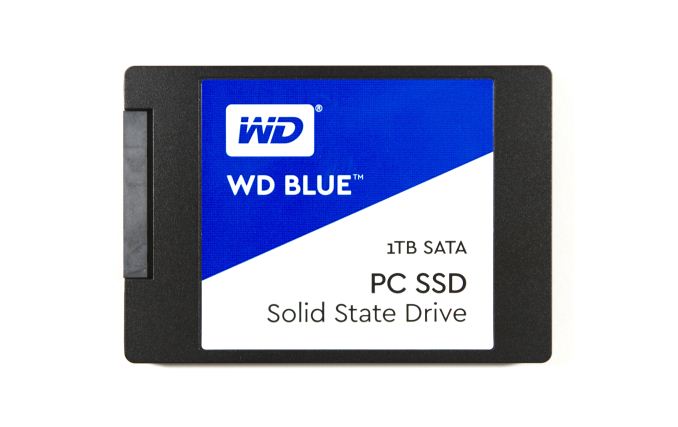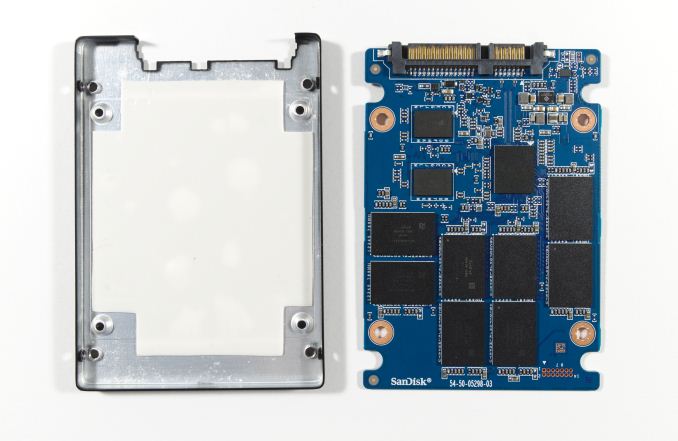The Western Digital Blue (1TB) SSD Review: WD Returns to SSDs
by Billy Tallis on October 11, 2016 8:00 AM EST- Posted in
- SSDs
- Storage
- Western Digital
- SanDisk

Five months after completing its acquisition of SanDisk, Western Digital is introducing SSDs under the WD brand for the consumer market. The WD Blue is the mainstream SATA offering and is derived from the SanDisk X400. While not exactly the first Western Digital SSD in blue, the WD Blue is the beginning of a new era for the WD brand and is an acknowledgment that SSDs are now mainstream consumer products that exist alongside or displace hard drives instead of just occupying a high-end niche.
The SanDisk X400 was announced at the beginning of this year as the new flagship of SanDisk's business/OEM client SSD family. When we reviewed it in May we were pleasantly surprised to find that it raised the bar for the performance and power efficiency of planar TLC SSDs and was a credible mid-range drive, not just an entry-level budget-oriented product. The WD Blue SSD uses the same hardware platform as the SanDisk X400, but with some changes to the firmware. Most notably, the WD Blue reserves a bit more spare area and thus has capacities of 250GB, 500GB and 1000GB where the X400 has capacities of 128GB–1024GB. There are minor differences to the performance specifications and the WD Blue has only a three year warranty compared to the X400's five years. (Though still better than the two year warranty carried by the current WD Blue hard drives.)
| Western Digital WD Blue Specifications | |||||
| Capacity | 250GB | 500GB | 1000GB | ||
| Form Factor | 2.5" 7mm SATA or M.2 2280 SATA | ||||
| Controller | Marvell 88SS1074 | ||||
| NAND | SanDisk 15nm TLC | ||||
| Sequential Read | 540 MB/s | 545 MB/s | 545 MB/s | ||
| Sequential Write | 500 MB/s | 525 MB/s | 525 MB/s | ||
| 4KB Random Read | 97k IOPS | 100k IOPS | 100k IOPS | ||
| 4KB Random Write | 79k IOPS | 80k IOPS | 80k IOPS | ||
| Average Power | 70 mW | ||||
| Max Power | 4.4 W | ||||
| Encryption | No | ||||
| Endurance (TBW) | 100 TB | 200 TB | 400 TB | ||
| Warranty | Three years | ||||
| MSRP | $79.99 | $139.99 | $299.99 | ||
All capacities of the WD Blue are available in either the 2.5" SATA form factor or as M.2 2280 cards. This continues the trend of recent mainstream SATA SSDs placing M.2 on an equal footing with the 2.5" form factor.
As a result of the increased spare area, the WD Blue has a higher write endurance rating than the SanDisk X400 and one of the highest endurance ratings of any TLC SSD. It even exceeds the rating on some capacities of the Samsung 850 Pro that comes with a 10 year warranty. Western Digital is pitching the WD Blue as suitable for heavy workloads, and even if its performance falls short of the best SATA drives it should last a very long time even when subject to a write-intensive workload.
| SSD Endurance Specifications Comparison | |||||
| Capacity | 240-256GB | 480-512GB | 960-1024GB | ||
| WD Blue | 100 TBW | 200 TBW | 400 TBW | ||
| SanDisk X400 | 80 TBW | 160 TBW | 320 TBW | ||
| OCZ Trion 150 | 60 TBW | 120 TBW | 240 TBW | ||
| OCZ VX500 | 148 TBW | 296 TBW | 592 TBW | ||
| Samsung 850 EVO | 75 TBW | 150 TBW | 150 TBW | ||
| Samsung 850 Pro | 150 TBW | 300 TBW | 300 TBW | ||
The construction of the WD Blue carries over the same metal case and plastic lid that SanDisk has been using for years. Inside our 1TB sample we find the same single-sided PCB as in the X400 and the thermal pad that covers nearly every component. The NAND is arranged in eight packages of 128GB each, while the Micron DRAM is split across two packages.
For this review the 1TB WD Blue will be compared against most of the other 1TB-class SATA drives we have tested. The current competition in the marketplace consists primarily of the preceding SanDisk X400, cheaper planar TLC SSDs such as the OCZ Trion 150, MLC SSDs that are mostly significantly more expensive, and 3D TLC SSDs such as the Samsung 850 EVO and Crucial MX300. Note that while we have already reviewed the 750GB Crucial MX300, in this review we are comparing against the 1050GB MX300 that will be covered by an upcoming review of the wider range of MX300 capacities that are now available.
| AnandTech 2015 SSD Test System | |
| CPU | Intel Core i7-4770K running at 3.5GHz (Turbo & EIST enabled, C-states disabled) |
| Motherboard | ASUS Z97 Pro (BIOS 2701) |
| Chipset | Intel Z97 |
| Memory | Corsair Vengeance DDR3-1866 2x8GB (9-10-9-27 2T) |
| Graphics | Intel HD Graphics 4600 |
| Desktop Resolution | 1920 x 1200 |
| OS | Windows 8.1 x64 |
- Thanks to Intel for the Core i7-4770K CPU
- Thanks to ASUS for the Z97 Deluxe motherboard
- Thanks to Corsair for the Vengeance 16GB DDR3-1866 DRAM kit, RM750 power supply, Carbide 200R case, and Hydro H60 CPU cooler

















75 Comments
View All Comments
Magichands8 - Wednesday, October 12, 2016 - link
That's funny you should say that since I've been noticing it for years. Every single time I move around large files to reorganize or back them up, in fact. But I'm sure that I'm the only non-video editing person on the planet who doesn't use his computer exclusively for reading and writing tiny text files and browsing the internet. I'm also sure that I'm the only who would have a problem paying a premium for very low capacity devices just so I could experience their limitations.Michael Bay - Thursday, October 13, 2016 - link
Oy vey, nobody in the market cares for my special snowflake wants, it`s anudda shoah!mapesdhs - Friday, October 14, 2016 - link
You need more explosions in your posts. ;Dbeginner99 - Wednesday, October 12, 2016 - link
It's cheap but not really excitingly cheap. Doesn't really beat the aged MX200 which also comes with MLC NAND which I deem superior to this TLC low-end crap. Only advantage this has over MX200 is price. Good for a cheapo game-drive maybe but would avoid as OS drive.Arnulf - Wednesday, October 12, 2016 - link
Ewww, 15nm planar TLC along with WD branding.JimmiG - Wednesday, October 12, 2016 - link
I remember the time when the 850 Evo was considered a "budget" SSD. Now it's almost a high-end SSD.haukionkannel - Wednesday, October 12, 2016 - link
And the price of evo is still going up. Hopefully there will be stop to it eventually.Impulses - Wednesday, October 12, 2016 - link
It's not really going up, just plateau'ing hard, sales might be happening slightly less frequently lately, I dunno... I do remember seeing the 1TB under $300 a number of times but it's mostly been just over $300 for well over a year.I paid $320-ish for two back in July-August 2015 when they were first starting to get close to $300. It's still faster than the field and brand alone is probably sustaining their ability to charge a premium.
mapesdhs - Friday, October 14, 2016 - link
Maybe it depends on where you live, but the 850 EVO went up a lot where I am (UK). Back in Jan this year the 250GB was 53 UKP, now the same model is 85 UKP. Samsung is exploiting demand for what used to be a well priced, reliable product to give the model a premium image that's pushing its cost far above where it really should be. This has happened before, eg. when the 830 series shot up in early 2013 after strong demand, which helped ensure all other brands didn't lower their prices.TheinsanegamerN - Friday, October 14, 2016 - link
what HASNT shot up in price in the UK post-Brexit vote?